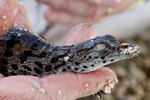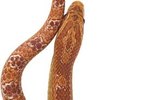
Reptiles fall in a category somewhere between mammals, who are warm-blooded and usually have fur or hair, and amphibians, who spend a lot of time in the water and have a less complex circulatory system. Although reptiles share some of the same traits as mammals and amphibians, their unique combination of these characteristics puts them in a class by themselves.
Body Temperature
Reptiles use sun and shade to regulate their internal body temperature, since they are ectothermic, or cold-blooded. This trait also means that if a reptile gets too cold he will become sluggish and tired. Reptiles sunbathe to increase their internal temperature, and hide in shady places or underground when they need to cool off or avoid overheating. Amphibians also are cold-blooded, but frequently use water for temperature control instead of holes or burrows.
Skin
Unlike amphibians, who have moist, slimy skin, reptiles have dry, scaly skin. Some reptiles have pronounced scales, like most snakes, while others have flesh that appears to be covered in small warts or horns. Their tough skin protects them against injury and prevents moisture loss in arid environments. A reptile's skin also has a complete covering of keratin, the substance that makes up hair and horns in other animals, for extra toughness. They do not have hair or oil-producing follicles.
Heart
Reptiles have a four-chambered heart. This further separates reptiles from amphibians. It also makes them similar to mammals, whose hearts have four chambers. The chambers in a reptile's heart function the same way they do in mammals, keeping oxygenated and unoxygenated blood separate. An amphibian's three-chambered heart, in comparison, allows freshly oxygenated blood to mix with blood that already has passed through the body.
Reproduction
Most reptiles lay eggs that have a thick, leathery skin. When the young hatch, they are fully formed and ready to begin life on their own. With the exception of a few types of reptiles, like crocodiles and some snakes who guard the nest, the parents do not tend to the young at all. The female lays a nest and then leaves. A few kinds of reptiles, however, bear live young.
Food
Since reptiles don't use internal energy to keep their body warm, they don't need nearly as much food as mammals. On average, they eat 30 to 50 times less than warm-blooded animals and birds. Most reptiles are carnivores, and eat small insects or other animals, but a few are herbivores and only eat plants.
Numbers
Reptiles are divided into four basic groups: snakes and lizards, of which there are about 8,500 species; crocodiles and alligators, which include approximately 25 species; turtles and tortoises, which include over 250 species; and two known species of tuatara.
References
Photo Credits
-
NA/AbleStock.com/Getty Images




